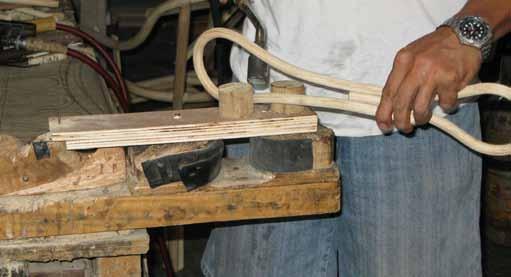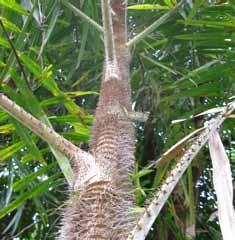
4 minute read
FUNCTIONS IN THE RATTAN AND BAMBOO VALUE CHAINS
The Department of Environment and Natural Resources As in plantation wood, the most visible enabling organization is the DENR since both rattan and bamboo are classified as non-timber forest products. The land where the POs plant their rattans had been handed over to them by the Government through the DENR.
The latter is also involved in the grant of permits, inspection and checking of rattan poles that are in the process of shipment to their respective destinations.
Advertisement
Bamboo does not attract as much attention as rattan in terms of regulatory control by the DENR.
PNOC They support POs that are within areas under their jurisdiction by providing them rattan seedlings and through the extension of assistance in getting rattan cutting permits from the DENR.
DTI has no long-term program for rattan and bamboo although some rattan and bamboobased products of BAHANDI members are among those that are promoted in trade fairs and exhibits. Nationally, research organizations such as ERDB, FPRDI, PCARRD and the academe have done a number of research projects on bamboo and rattan but no direct engagement nor assistance have so far been provided to bamboo and rattan growers, processors, and traders in Leyte. Trade organizations such as CFIF and PCHI could also potentially support the rattan and bamboo sub-sectors in Leyte, but so far, these organizations’ activities and programs have not reached the Island.
fUnCTIonS In ThE RaTTan anD bamboo VaLUE ChaInS
Rattan The functions in the rattan value chain, as shown in Figure 7, include the provision of specific inputs, production and harvesting, primary processing, pole trade, furniture making and trade, and consumption. Farmers and POs generally undertake all of the first three functions. Traders buy the rattan poles and sell them to furniture makers within and outside Leyte, Furniture makers process rattan. Their workshops also serve as their display areas. Homeowners and commercial establishments buy rattan-made products.
Not all POs in Leyte plant rattan. There are some who do have members who were engaged in rattan pole collection in the past as a source of livelihood income. Collection has not been limited to planted rattan poles, since it would require several days for them to return
from rattan collection expeditions. Rattan collection is difficult and risky, and gatherers are equipped only with the most basic tools such as a bolo or hatchet when harvesting rattans. Falling from trees around which the viney rattan stem clings is not uncommon. Farmers pull the rattan poles away from the trees, remove the leaf sheathes and the spines around the poles, and then cut them to length for easier hauling, which is usually done by carrying the forest product on their backs as they return to the rattan depots in the center of the Barangay on foot.
In the Barangay center, primary processing of the pole is done such as scraping, piling, air drying, and bundling. Scaling (inspection) and pricing is done in the presence of the buyer or trader. Scaling serves as the basis of payment to the gatherers, who would normally receive only the balance since payment in general, had already been made in advance by the buyers. Traders have their own trucks that are used to haul the bundled rattans to a central storage area or directly to rattan furniture or handicraft makers or to buyers from other provinces.
Rattan furniture makers process the rattan into chairs, sala sets, tables and other high-end type of furniture. Rattans are cut to length and bent to the desired configuration as per the design of the product. Weaving of furniture components is a time-consuming operation in rattan furniture making. The finished products are applied with varnish, stains and other finishing materials and then are put on display for potential buyers to see. There is little marketing effort on the part of furniture makers to advertise their products.
Bamboo The bamboo value chain is more straightforward than the plantation and rattan value chains. Like rattan, there is negligible input in bamboo production as the plant tends to grow naturally with very little human intervention. Bamboo clumps occur in patches along the banks of rivers, creeks or streams and can also be found surrounding backyards or as hedges around farms. There are two modes in which farmers sell their bamboo. One is by direct selling to furniture makers or consumers. In this mode, the farmers do the cutting, harvesting, transport, and directly deliver them to the furniture maker. Another mode is through the “pakyaw” system, where the buyer, usually the furniture maker or a consumer planning to build a house, negotiates with the farmer for the price of the bamboo poles in a clump or several clumps in a stand. The buyer then takes care of hiring people to cut, remove branches and thorns, haul, and transport the bamboo poles to the furniture workshop.
Bamboo poles are air-dried before they are processed into furniture. The lower portions are made to stand on end, while the top portions are laid in a horizontal position until they are dry and deemed fit for processing. The poles are cut to length, the skin scraped off, and then worked depending on the part of the furniture they would be put into. The bamboo furniture components are assembled according to the design, sanded to make the surface smooth, then exposed for some time prior to application of varnish or sold as is without any finish. Customers are generally walk-in buyers who want a set for their house, or buyers from Tacloban City or nearby Province of Samar, who have their own bamboo furniture stores.





